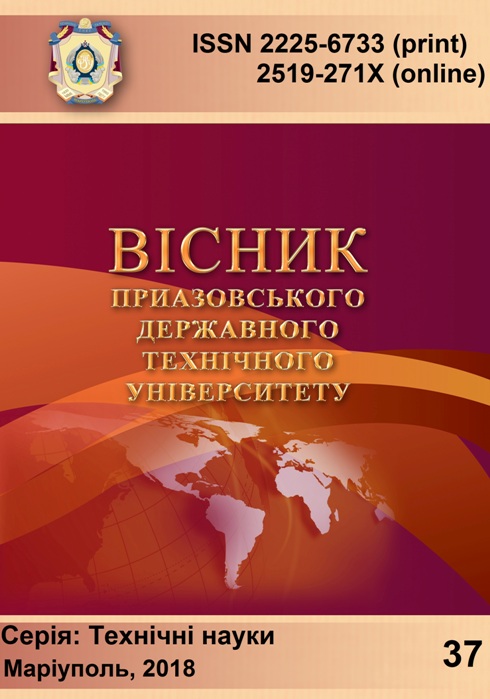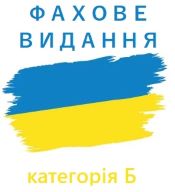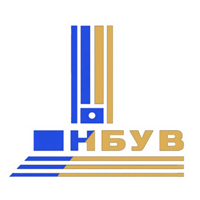Нанотехнології в машинобудуванні: плазмове модифікування різбонарізного інструменту
DOI:
https://doi.org/10.31498/2225-6733.37.2018.160266Ключові слова:
зміцнення, плазма, гребінка, різьбонарізання, субмікроструктуруванняАнотація
У роботі досліджено процес плазмового поверхневого модифікування різьбонарізної гребінки зі сталі Р6М5 з утворенням субмікрокристалічної структури на поверхні інструменту. При певних технологічних умовах плазмового модифікування інструменту зі швидкорізальної сталі створюються можливості додаткового підвищення твердості і теплостійкості за рахунок утворення в модифікованої зоні після фінішної відпустки ультрадисперсної мартенситно-карбідної структури. Дослідження показали, що підвищення твердості і теплостійкості різальних крайок гребінок зі сталі Р6М5 при плазмовому модифікуванні обумовлено дією субструктурного, дислокаційного і твердорастворного механізмів зміцнення. В структурі модифікованої зони утворюються надзвичайно дисперсні карбідні частки (близько 100 нм), які грають роль бар’єрів і перешкоджають росту аустенітного зерна і, отже, кристалів мартенситу при швидкісному загартовуванню як в рідкій, так і в твердій фазі. Разом з тим, ступінь підвищення HV і К4р58 незначна, а підвищення вмісту залишкового аустеніту і додаткове насичення твердого розчину вуглецем і карбідообразующими елементами припускають ефективність виконання фінішної об’ємної відпустки і реалізацію твердіння з виділенням вторинних карбідів. Досягаються значення твердості і теплостійкості різальних крайок, що перевищують рівень плазмового модифікування без оплавлення поверхні для масивного інструменту зі швидкорізальної сталі і, відповідно, плазмової обробки з мікрооплавленням поверхні, названому плазмовим мікро- та наноструктуруванням. Ступінь дисперсності структури після комплексного зміцнення на порядок вища, ніж при плазмовій обробці масивного інструменту, аналогічна плазмовій обробці з мікрооплавлінням і на 2-3 порядки вища, ніж при стандартній об’ємній термообробціПосилання
Список использованных источников (ГОСТ):
Иноземцев Г.Г. Проектирование металлорежущих инструментов / Г.Г. Иноземцев – М. : Машиностроение, 1984. – 272 с.
Родин П.Р. Металлорежущие инструменты / П.Р. Родин. – М. : Высшая школа, 1974. – 400 с.
Самотугин С.С. Плазменное модифицирование резьбонарезного инструмента / С.С. Самотугин, О.А. Христенко // Вісник Приазовського державного технічного університету. – 2017. – № 34. – С. 105-112. – (Серія : Технічні науки).
Самотугин С.С. Математическая модель процесса поверхностного плазменного упрочнения резьбонарезной гребенки / С.С. Самотугин, О.А. Христенко, В.А. Мазур // Захист металургійних машин від поломок : Зб. наук. пр. – 2014. – Вип. 16. – С. 14-16.
Горелик С.С. Рентгенографический и электронно-оптический анализ / С.С. Горелик, Я.Н. Расторгуев, Ю.А. Скаков. – М. : Металлургия. – 1971. – 368 с.
Васильев Д.М. Дифракционные методы исследования структуры / Д.М. Васильев. – М. : Металлургия. – 1977. – 247 с.
Самотугин С.С. Плазменное упрочнение инструментальных материалов / С.С. Самотугин, Л.К. Лещинский. – Донецк : Новый мир, 2003. – 338 с.
Самотугин С.С. Эксплуатационные свойства инструментальных сталей после комплексного объемно-поверхностного упрочнения / С.С. Самотугин, А.В. Пуйко, Н.Х. Соляник, Е.Б. Локшина // Металловедение и термическая обработка металлов. – 1997. – № 5. – С. 2-6.
Крянина М.Н. Термическая обработка быстрорежущей стали с применением непрерывного лазерного излучения / М.Н. Крянина, А.М. Бернштейн, Т.П. Чупрунова // Металловедение и термическая обработка металлов. – 1989. – № 10. – С. 7-12.
Бровер Г.И. Особенности строения и свойства инструментальных сталей после высококонцентрированного нагрева и отпуска / Г.И. Бровер, В.Н. Варавка, А.П. Русин // Физика и химия обработки материалов. – 1988. – № 5. – С. 107-113.
Залкин В.М. Некоторые аспекты теории эвтектических сплавов в свете новых экспериментальных данных / В.М. Залкин // Металловедение и термическая обработка металлов. – 1993. – № 11. – С. 2-7.
Гончаренко И.А. Механизмы сверхпластичности и структурообразования в гетерофазных металлических материалах при фазовых переходах / И.А. Гончаренко, А.З. Гвоздеев // Металлы. – 1992. – № 3. – С. 166-171.
Долженков И.Е. Сфериодизация карбидов в стали / И.Е. Долженков, И.И. Долженков. – М. : Металлургия. – 1984. – 143 с.
Самотугин С.С. Плазменное микро- и наноструктурирование поверхности инструментальных сталей / С.С. Самотугин, В.А. Мазур // Упрочняющие технологии и покрытия. – 2013. – № 4. – С. 29-37.
Гуляев А.П. Металловедение / А.П. Гуляев. – М. : Металлургия. – 1986. – 554 с.
Молотилов Б.В. Нанотехнологии – новое направление в прецизионной металлургии / Б.В. Молотилов // Сталь. – 2005. – № 1. – С. 97-100.
Валиев Р.В. Структура и свойства металлических материалов с субмикрокристаллической структурой / Р.В. Валиев, А.В. Корзников, Р.Р. Мулюков / Физика металлов и металловедение. – 1992. – № 4. – С. 70-86.
Шулаев В.М. Инженерия неорганических наноматериалов / В.М. Шулаев // Мир техники и технологий. – 2007. – № 2. – С. 62-64.
References:
Inozemtsev G.G. Proektirovanie metalorejuschieh instrumentov [Engineering cutting tools]. Moskow, Mashunostroinie Publ., 1984. 272 р. (Rus.)
Rodin P.R. Metalorejuschie instrumentu [Cutting tools]. Moskow, Vuschay shkola Publ., 1974. 407 р. (Rus.)
Samotugin S.S., Khrystenko O.A. Plazmenoe modifizurovanie rezbonareznogo instrumenta [Plasma modification of a threading tool]. Vestnik Priazovskogo gosudarstvennogo tekhnicheskogo universiteta. Seriia: Tekhnicheskie nauki – Reporter of the Priazovskyi State Technical University. Section: Technical sciences, 2017, no. 34, pp. 105-112. (Rus.)
Samotugin S.S., Khrystenko O.A., Mazur V.A. Matematicheskaya model prozesa plazmenogo poverhnostnogo uprochneniya rezbonareznoi grebenki [Mathematical model of the process of surface plasma hardening thread-cutting comb]. Zahust metalurgiinuh machun vid polomok – Protection of metallurgical machines from breakdowns, 2014, no. 16, pp. 14-16. (Rus.)
Gorelik S.S., Rastorguev Y.N., Skakov Y.A. Rentgenograficheskii i elecktronno-opticheskii analiz [X-ray and electron-optical analysis]. Moskow, Metallurgy Publ., 1971. 368 p. (Rus.)
Vaasiel’ev D.M. Difrakzuonnue metodu issledovaniya structuru [Diffractional structure analysis methods]. Moskow, Metallurgy Publ., 1977. 247 p. (Rus.)
Samotugin S.S., Leschinskiy L.K. Plazmenoe uprochnenie instrumentalnuh materialov [Plazma hardening of tools material]. Donetsk, Novui mir Publ., 2003. 338 p. (Rus.)
Samotugin S.S., Pyiko A.V., Solyanik N.H., Lokschuna E.B. Ekspluatazuonue svoistva instrumentalnuh stalei posle kompleksnogo ob’emno-poverhnostnogo yprochneniya [Performance properties of tool steels after complex bulk-surface hardening]. Metallovedenie i termicheskaya obrabotka metallov – Metal science and heat treatment of metals, 1997, no. 5, pp. 2-6. (Rus.)
Kryanina M.N., Bernschtein A.M. Chuprunova T.P. Termicheskaya obrabotka bustroreguscei stali s primeneniem nepreruvnogo lazernogo izlucheniya [Heat treatment of high-speed steel using continuous laser radiation]. Metallovedenie i termicheskaya obrabotka metallov – Metal science and heat treatment of metals, 1989, no. 10, pp. 7-12. (Rus.)
Brover G.I., Varavka V. N., Rusin A.P. Osobennosti stroeniya i svoista instrumentalnuh stalei posle vusokokonzentrirovanogo nagreva i otpuska [Features of the structure and properties of tool steels after highly concentrated heating and tempering]. Fizika i himiya obrabotki materialov – Physics and chemistry of materials processing, 1988, no. 5, pp. 107-113. (Rus.)
Zalkin V.M. Nekotorue aspect teorii evtekticheskih splavov v svete novuh eksperemental’nuh dannuh [Some aspects of the theory of eutectic alloys in the light of new experimental data]. Metallovedenie i termicheskaya obrabotka metallov – Metal science and heat treatment of metals, 1993, no. 11, pp. 2-7. (Rus.)
Goncharenko I.A., Gvozdeev A.Z. Mehanizmu sverhplastichnosti istructuroobrazovaniya v geterofaznuh metalicheskih materialah pri fazovuh perehodah [Mechanisms of superplasticity and structure formation in heterophase metallic materials during phase transitions]. Metallu – Metals, 1992, no. 3, pp. 166-171. (Rus.)
Dolgenikov I.E., Dolgenikov I.I. Sveriodizazuya karbidov v stali [Spiderodization of carbides in steel]. Moskow, Metallurgy Publ., 1984. 143 p. (Rus.)
Samotugin S.S., Mazur V.A. Plazmenoe micro- i nanostructurirovanie poverhnosti instrumrntalnuh stalei [Plasma micro- and nanostructuring of the surface of tool steels] Uprochnyauschie tehnologii i pokrutiya – Strengthening technologies and coatings, 2013, no. 4, pp. 29-37. (Rus.)
Gulyav A.P. Metallovedenie [Metal science]. Moskow, Metallurgy Publ., 1986. 554 p. (Rus.)
Molotilov B.V. Nanotehnologii – novoe napravlenie v prezezionnoi metalurgii [Nanotechnology - a new direction in precision metallurgy]. Stal’ – Steel, 2005, no. 1, pp. 97-100. (Rus.)
Valiev R.V., Korznikov A.V., Mulykov R.R. Structura i svoistva metallicheskih materialov s submikrokristallicheskoi structuroi [Structure and properties of metallic materials with submicrocrystalline structure]. Fizika metallov i metallovedenie – Metal physics and metallography, 1992, no. 4, pp. 70-86. (Rus.)
Schulaev V.M. Ingeneriya neorganicheskih nanomaterialov [Inorganic Nanomaterials Engineering]. Mir tehniki i tehnologii – The world of equipment and technology, 2007, no. 2, pp. 62-64. (Rus.)
##submission.downloads##
Опубліковано
Як цитувати
Номер
Розділ
Ліцензія
Журнал "Вісник Приазовського державного технічного університету. Серія: Технічні науки" видається під ліцензією СС-BY (Ліцензія «Із зазначенням авторства»).
Дана ліцензія дозволяє поширювати, редагувати, поправляти і брати твір за основу для похідних навіть на комерційній основі із зазначенням авторства. Це найзручніша з усіх пропонованих ліцензій. Рекомендується для максимального поширення і використання неліцензійних матеріалів.
Автори, які публікуються в цьому журналі, погоджуються з наступними умовами:
1. Автори залишають за собою право на авторство своєї роботи та передають журналу право першої публікації цієї роботи на умовах ліцензії Creative Commons Attribution License, яка дозволяє іншим особам вільно розповсюджувати опубліковану роботу з обов'язковим посиланням на авторів оригінальної роботи та першу публікацію роботи в цьому журналі.
2. Автори мають право укладати самостійні додаткові угоди, які стосуються неексклюзивного поширення роботи в тому вигляді, в якому вона була опублікована цим журналом (наприклад, розміщувати роботу в електронному сховищі установи або публікувати у складі монографії), за умови збереження посилання на першу публікацію роботи в цьому журналі.









